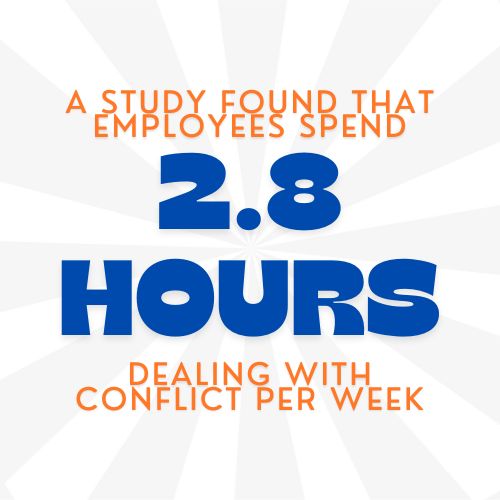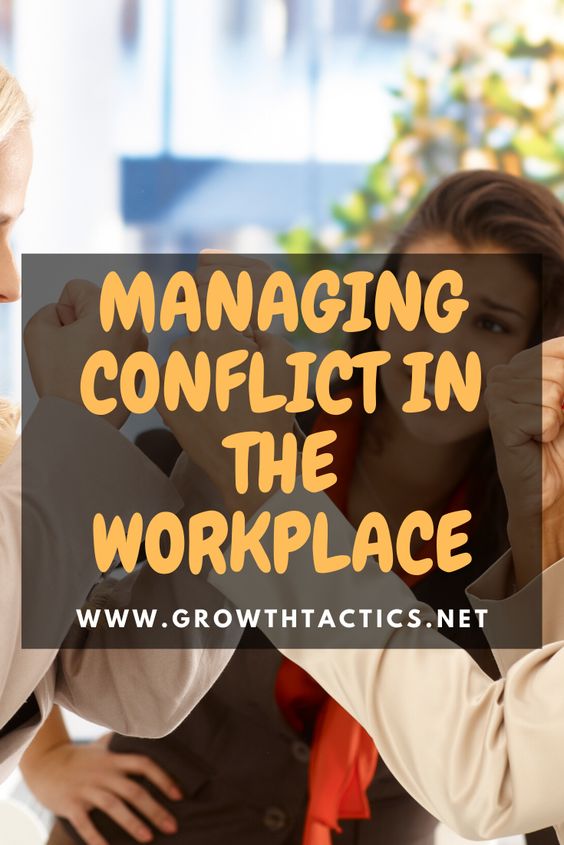In a study done by the American Management Association, supervisors spend on average 24% of their day attempting to resolve conflict in the workplace. This can be a conflict that the supervisor is directly involved in or between coworkers that the supervisor must get under control before it becomes an issue.
In this article, you will learn tips for resolving conflict in the workplace quickly and effectively. This will allow you to take back more of your day and not constantly put out fires between employees.
Many of these tips are geared toward supervisors but are helpful for anyone who wants to learn how to handle conflict at work and promote a happy work environment.

Jump To Section
What is Conflict Management in the Workplace? (Defining Conflict)
The purpose of managing conflict in the workplace is not to avoid all conflict. Some conflict is good for fostering ideas.
Everyone in your work center will have their own ideas and opinions. You don’t want them to not share them just to avoid conflict. You want to help them express their ideas without fostering negative conflict.
So what is conflict management in the workplace?
Managing conflict in the workplace is about keeping the conflict in the healthy range and not allowing your employees to get into pointless arguments. As a leader, you should facilitate conflict resolution efficiently and peacefully.
While some conflict is healthy and can lead to great ideas and advancements, much of it is not beneficial. It’s important to be able to determine healthy workplace conflict as opposed to unhealthy workplace conflict.
Having employees constantly argue and not get along is bad for employee relations, production, and ultimately, the success of the team.
Also, a conflict between two members typically affects more than just those two members of your team. Many times, other members of the team get dragged into the conflict. Therefore, managing conflict in the workplace must be a priority for a leader.
The most effective strategy for managing conflict is to avoid it altogether but that will not always be possible and will sometimes hold the team back.
Before we get into the strategies for conflict management, let’s discuss the reasons for conflict.
Bell & Hart’s 8 Reasons for Conflict

Conflicting Resources
Resources in the workplace can be anything from pencils to computers. Many times, these resources are limited. Conflict can happen when employees are trying to utilize the same resources.
Example of This Type of Conflict
An example of conflicting resources could be something like employees arguing about needing to use a computer when no other computers are available.
Conflicting Styles
Everyone is different. Even though work styles may be similar between employees, the way employees get the job done may differ. Conflict may arise when employees don’t agree with the way somebody else is doing the job.
Example of This Type of Conflict
For example, if there is an employee that has a fast-paced work style and a slower more methodical employee. Both of these employees could get upset with each other.
The faster-paced employee may get upset because they believe the other employee is too slow. On the other hand, the slower-paced employee may get upset with the faster-paced employee because they believe they make too many mistakes.
Conflicting Perceptions

Perceptions can lead to conflict. People perceive things differently. Especially when it comes to communication. Have you ever been in a situation where you said something that you thought was fine, only to find out you angered somebody? This is because of the way they perceived what you said.
Example of This Type of Conflict
An example of conflicting perceptions is miscommunication between employees. Let’s say one employee says that they will get to a task as soon as they can. The other employee perceives that to mean they will get it done before the end of the day. The other person meant they had higher priorities and might not be able to get to them until the end of the week. When the employees come in the next day there is an argument because the employees each perceived the communication differently.
Conflicting Goals
People’s ultimate goals don’t always align with each other. This can also cause conflict. There are many different goals in the workplace. When it comes to work some people just want to do a good job, some people want more money, some people want power and recognition just to name a few.
Click here to learn how to easily set SMART goals for more success.
Example of This Type of Conflict
Say one employee has a goal to get promoted. Another employee’s goal is to get the job done and go home. This could cause conflict between the two employees. For example, the employee seeking promotion starts doing a lot of extra stuff to impress management. This causes the other employee to have to start doing some of the employee’s duties to get the job done and go home. The employee that just wants to get the job done may get upset with the employee seeking promotion due to the increased workload.
Conflicting Pressures
Pressures to get different tasks done can also cause conflict in the workplace. These pressures can come from different bosses or even the same boss. A lot of times this can arise from people wanting help from others on their tasks or even needing the same resources to accomplish the tasks.
Example of This Type of Conflict
Assume there are two employees in a factory. Employee “A”s boss is pressuring them to get a product made as quickly as possible to fulfill an order. Employee “B” is in the Quality Assurance department and is being told to raise the quality of the products going out. When employee “B” rejects multiple of employee “A”s products due to an increase in defects, conflict arises between the two.
Conflicting Roles
Roles in the workplace may cause conflict from time to time. This can be the roles of supervisors and subordinates or the roles of peers. This is especially true when roles and duties or powers of those roles are not communicated and understood by everyone on your team.
To learn more about team member roles click here.
Example of This Type of Conflict
An example of this could occur when a manager puts team member “A” in charge of a project. Team member “B” is the most senior member of the team and believes he should be in control. This causes conflict when team member “A” tries to get team member “B” to perform a certain task.
Different Personal Values
Personal values are what we use to guide our actions. Many times, people may not want to take certain actions due to personal beliefs and values. There may be situations in the workplace that arise where conflict arises due to differences in personal beliefs.
Example of This Type of Conflict
Worker “A” knowingly sends out products with defects. Worker “B” believes knows that Worker “A” is sending out defective products and believes this is not right. When Worker “B” confronts Worker “A” conflict arises.
Unpredictable Policies
When new policies are implemented, confusion can occur among employees. Some employees may not even agree with the new policies. This confusion and unwillingness to change can lead to conflict, especially between management and employees.
Example of This Type of Conflict
Worker “A” works in an office setting where the supervisor continually put out policies. It seems like every week a new policy is released. Recently the supervisor put out a new policy that there would be no personal cell phones in the work area. This causes conflict with Worker “A” because she has kids and wants to be able to know if something happens to them.
Tips to Resolve Conflict in the Workplace and Improve Employee Relations
Now that we understand the reasons for conflict, let’s talk about ways to resolve conflict in the workplace.
1 . Define the problem. What is the source of the conflict?
Typically, the first step in workplace conflict resolution is defining the problem. If you don’t understand what the problem is, you can’t fix it.
Sometimes this can be tricky.
One party may believe the problem is one thing. While the other party thinks the problem is something else. This is why it’s vital to get both sides of the story before working on fixing it.
Often, people may even say the problem is one thing but when you dig a little deeper, you realize the problem is something else entirely. Using root cause analysis like the “5 whys” may be helpful in this situation.
2. There are no winners if everybody is trying to win an argument.
When it comes to conflict everyone can’t try to be the winner. In that case, everybody loses. Even the person that won the argument will likely have a hard time working with that person in the future. They may have even lost some of the respect of other coworkers. The best option is to look for a solution that everybody is happy with.
Many times, managing conflict in the workplace becomes a negotiation. In a negotiation, the best outcome is a win-win for both sides. Click here for tips and tricks to improve your negotiating skills.
3. Communication is the key.

Listening is extremely important in communication. Especially when it comes to managing conflict in the workplace.
Too often, we are not listening to what people are saying. Instead, we are thinking about what we are going to say next. Listening to the other parties involved is how we get to the root of the problem instead of just causing more issues by not hearing each other. Also, we must ensure we are talking about the issue at hand and not attacking each other during conflict.
For more tips on becoming a master communicator click here.
4. Pick your battles.
Choosing your battles is a great way to avoid unnecessary conflict in the workplace and maintain employee relations. Not all battles are worth fighting.
Too often, a boss attempts to fight every battle and it just makes them difficult to work with. Sometimes it’s better just to let some things go.
Think to yourself “Is this going to affect me tomorrow? How about the next day? How about a week from now?”. If the answer to those questions is no is the battle worth fighting? Choosing your battles wisely also gives you a little more clout when you do have something worth battling for.
5. Keep your emotions in check.
Office conflict resolution is all about keeping your emotions at bay. Getting too emotional can get you in trouble when it comes to conflict resolution. By keeping your emotions in check, you ensure you don’t say something you can’t take back.
Also, when you stay calm it tends to have a calming effect on those around you. Additionally, when you are calm, people tend to hear your message a lot more clearly. If you find yourself struggling to keep your emotions under control, you may have to walk away for a bit or do something else to calm yourself down.
For ways to minimize or eliminate stress in the workplace click here.
6. Try not to look for a person to blame.
Spend your time and energy looking for a solution. Pointing fingers and looking for a person that’s at fault doesn’t do any good. It just takes away from the problem at hand.
Also, when you start blaming people they become defensive. When people become defensive, they are a lot less willing to work together on a solution. Even if somebody did mess up, it is typically best just to say, “You messed up let’s fix it” and not dwell on the fact that they messed up.
7. Keep the conversation on topic and goal-orientated.
This tip goes hand in hand with not trying to win the argument. To win the argument, we bring up things that have been done or said in the past or things that bother us that are completely unrelated to the problem at hand.
This takes focus away from the current issue and just upsets people. Keep the focus on the current issue unless the past or other issues are extremely important to the current problem.
8. Leave your ego at the door.
Many times, our want to win an argument is due to our ego. When somebody gets called out on something, they feel attacked even when they are in the wrong.
When we let our egos get the best of us, we have a hard time hearing what other people are saying. Also, we feel like we can’t give in or it makes us look weak.
For these reasons, we need to keep our egos in check and listen to and rationalize what people are saying. Don’t let your ego get in the way of a good solution. The ego can be a big barrier to effectively dealing with conflict in the workplace.
9. Admit you were wrong.
This can be one of the quickest ways to end an argument. Even if you feel like you did nothing wrong you can apologize that the other person is upset.
Saying you’re sorry can get the other person to stop being defensive because it shows you’re trying to find a solution. This is also a good way to make sure your ego is in check and not getting in the way of a solution.
Everyone makes mistakes click here for tips to get past mistakes.
10. Talk it over in person.
Meeting face-to-face is almost always the best way to solve a conflict. When you discuss issues over the phone or even worse yet, via email or text, parts of the message may be lost or misunderstood.
While communicating, body language and tone of voice are as important as the words that are said. Without body language and tone there is a much bigger risk that parts of the message will be misunderstood, leading to more conflict.
11. Find common areas of agreement.
No matter what the issue is, there are likely things that both parties agree on. Look for these areas and build off them.
An old sales technique called three yeses is very useful in these situations. This technique involves asking three relevant questions where the answer will be yes. Once the other party or parties have answered the questions, they are more likely to be in a state of mind where cooperation and collaboration can happen.
Finding common ground between both parties can make managing conflict in the workplace much easier.
12. Build on successes.
One success leads to another. Each success can be like a stepping stone, leading to another. Make it a point to point out successes the parties involved have had toward resolving conflict. Even if it’s just a small step, it’s progress. Keep pushing forward until a resolution is reached.
13. Address Issues Promptly
Address conflicts as soon as they arise to prevent them from escalating. Timely intervention can lead to quicker resolution and minimize potential damage to working relationships.
Conduct regular check-ins with employees to discuss any concerns or issues they may be facing. By staying proactive, you can identify potential conflicts early and address them before they escalate.
14. Establish Clear Expectations
Establish clear expectations for workplace behavior and performance. By setting standards, employees understand what is expected of them and are more likely to adhere to these guidelines, reducing the likelihood of conflict.
Ensure that all employees are aware of and understand the expectations set for their role. Regular communication and training can help to prevent misunderstandings and conflicts.
15. Encourage Empathy
Encourage employees to consider the perspectives of their colleagues during conflict resolution. By understanding different viewpoints, employees can approach conflicts with empathy and compassion.
Reiterate the importance of active listening in conflict resolution, as it helps employees to empathize with their colleagues and better understand their concerns.
16. Focus on the Problem, Not the Person
When resolving workplace conflict, it’s important to focus on the problem, not the person. Avoid making personal attacks or assigning blame. Instead, work together to identify the root cause of the conflict and find a solution that works for everyone.
One way to focus on the problem is to use objective language. Stick to the facts and avoid making assumptions or generalizations. This will help keep the conversation focused on the issue at hand and prevent it from escalating into a personal attack.
17. Seek Mediation
In some cases, resolving workplace conflict may require the assistance of a neutral third party. Mediation involves bringing in a trained mediator to help facilitate the conversation and find a mutually beneficial solution.
To seek mediation, identify a qualified mediator and schedule a meeting with the parties involved. During the mediation, the mediator will help facilitate the conversation and work with both parties to find a solution that meets everyone’s needs.
18. Address Power Imbalances
Power imbalances can often contribute to workplace conflict. It’s important to address any power imbalances that exist and work to create a more equitable environment.
To address power imbalances, consider implementing policies or procedures that promote equity and fairness. Encourage open and honest communication and ensure that everyone’s voice is heard. This can help create a more inclusive and collaborative workplace culture.
19. Use Humor
Using humor can help diffuse tension and create a more positive environment for resolving conflict. It can help lighten the mood and create a more relaxed atmosphere for discussing difficult issues.
To use humor, consider injecting a little levity into the conversation. Share a funny story or joke to lighten the mood and create a more positive environment for resolving conflict.
20. Learn from the Conflict
Finally, it’s important to learn from the conflict and use it as an opportunity for growth and development. Reflect on the situation and identify areas for improvement in your communication, conflict resolution, and workplace culture.
To learn from the conflict, consider conducting a debriefing session to discuss what worked well and what could be improved. Use this information to make changes and improvements to your workplace culture and conflict resolution processes.
How to Be an Effective Mediator During Workplace Conflict
As a mediator, it is your responsibility to facilitate the resolution of conflicts in a fair, unbiased, and efficient manner. Being an effective mediator requires a combination of skills and strategies that can help parties involved in conflict find common ground and reach a mutually acceptable agreement. In this article, we will discuss the key steps and techniques for becoming an effective mediator during workplace conflict.
Understanding the Role of a Mediator
Before diving into the mediation process, it is important to understand the role and responsibilities of a mediator. A mediator acts as a neutral third party, facilitating communication and guiding the parties towards a resolution. Mediators should maintain impartiality, actively listen to all parties, encourage collaboration, and ensure confidentiality.
Creating a Safe and Respectful Environment
One of the first steps to effective mediation is establishing a safe and respectful environment for the parties involved. Encourage open communication, ensure privacy, and create a welcoming atmosphere that promotes trust and honesty. By fostering an environment of respect, you can help maintain a constructive and productive dialogue.
Active Listening and Empathy
Active listening and empathy play a crucial role in effective mediation. As a mediator, you must listen attentively to each party’s concerns, interests, and perspectives without judgment. Show empathy and validate their emotions to create a sense of understanding and trust. Reflecting back on what you’ve heard can also help the parties feel heard and understood.
Clarifying and Reframing Issues
During conflicts, emotions can cloud the issues at hand. As a mediator, it is essential to clarify and reframe the problems in a neutral and objective manner. Summarize the key points, ask clarifying questions, and reframe the issues to ensure a shared understanding among all parties. This process can help dispel misunderstandings and focus the discussion on finding solutions.
Facilitating Effective Communication
Effective communication is vital for resolving workplace conflicts. Encourage each party to express their thoughts and concerns while maintaining a respectful and non-confrontational tone. Help parties to communicate directly with each other and avoid interrupting or imposing your own opinions. When tensions rise, use appropriate techniques such as paraphrasing, summarizing, or asking open-ended questions to encourage deeper understanding and promote constructive dialogue.
Generating Options and Seeking Agreement
Once the parties have expressed their concerns, it is time to generate possible solutions or options. Encourage creative thinking and problem-solving while considering the interests of all parties involved. Help the parties explore various alternatives and evaluate the potential outcomes. Facilitate negotiations and guide the parties towards an agreement that meets their needs and addresses the core issues.
Documenting and Follow-up
To solidify the resolution reached during mediation, it is crucial to document the agreed-upon terms. Prepare a written agreement that outlines the agreed solutions, responsibilities, and any necessary actions going forward. Ensure all parties understand and sign the agreement to avoid future misunderstandings. Additionally, follow up with the parties after some time to make sure the implemented solutions are working effectively and address any potential concerns.
Final Thoughts
Managing conflict in the workplace can be tricky and may even take up a lot of your time but it’s something you as a leader need to take care of. Negative conflict can turn even the best employees into poor employees.
Many times, it doesn’t only affect those involved but it can also bring down the whole team. Use these tips and conflict resolution strategies to minimize the effects and keep your team performing at their best.
If you enjoyed this article on how to resolve conflict in the workplace, please don’t forget to share and subscribe using the buttons below.


